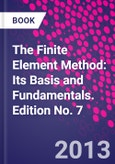The Finite Element Method: Its Basis and Fundamentals offers a complete introduction to the basis of the finite element method, covering fundamental theory and worked examples in the detail required for readers to apply the knowledge to their own engineering problems and understand more advanced applications.
This edition sees a significant rearrangement of the book's content to enable clearer development of the finite element method, with major new chapters and sections added to cover:
- Weak forms - Variational forms - Multi-dimensional field problems - Automatic mesh generation - Plate bending and shells - Developments in meshless techniques
Focusing on the core knowledge, mathematical and analytical tools needed for successful application, The Finite Element Method: Its Basis and Fundamentals is the authoritative resource of choice for graduate level students, researchers and professional engineers involved in finite element-based engineering analysis.
Please Note: This is an On Demand product, delivery may take up to 11 working days after payment has been received.
This edition sees a significant rearrangement of the book's content to enable clearer development of the finite element method, with major new chapters and sections added to cover:
- Weak forms - Variational forms - Multi-dimensional field problems - Automatic mesh generation - Plate bending and shells - Developments in meshless techniques
Focusing on the core knowledge, mathematical and analytical tools needed for successful application, The Finite Element Method: Its Basis and Fundamentals is the authoritative resource of choice for graduate level students, researchers and professional engineers involved in finite element-based engineering analysis.
Please Note: This is an On Demand product, delivery may take up to 11 working days after payment has been received.








